|
The Sun radio emission burst was observed with three instruments.

Tektronix MDO4104-6 Spectrum Analyzer Video
Tektronix MDO4104-6 Spectrum Analyzer
- The below Tektronix MDO4104-6 spectrum analyzer display shows the Sun radio emissions from 17.5 MHz to 24.0 MHz.
- The Sun radio emission is the white blueish color in the top blue spectrogram window.
- Radio stations
- The first set of strong vertical signals from the left edge are the 17.5 MHz to 17.9 MHz broadcasting stations.
- The second set of strong signals from the left edge are the
17 meter (18.068 MHz to 18.168 MHz) amateur radio band.
- Radio station WWV at 20.0 MHz
is the white vertical line in the spectrogram just over one division left of center.
- WWV distance is 1,511 km with a bearing of 105.3 degrees.
- The strong set of signals just right of the center frequency is the
15 meter
(21.0 MHz to 21.45 MHz) amateur radio band.
- The short thin horizontal lines in the spectrogram are weak lighting or weak RFI bursts.
- The antenna sensitivity peaks on the left side of the spectrogram.
- This results in the background noise being a lighter blue color on the left side of the spectrogram.
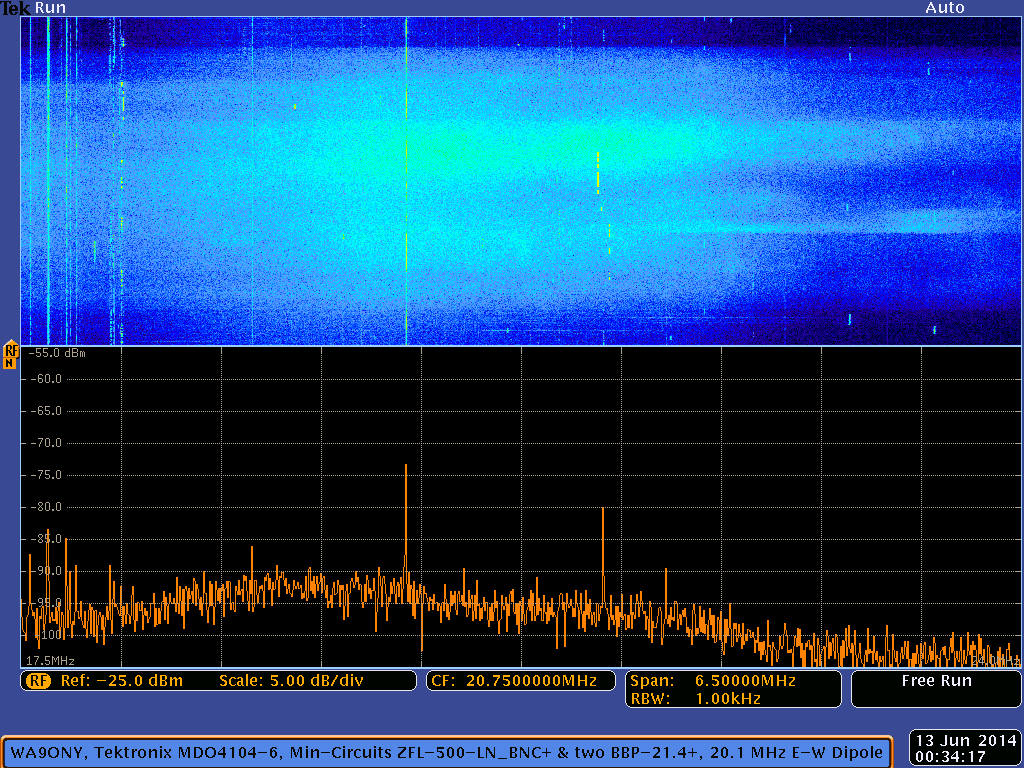

United States Frequency Allocations
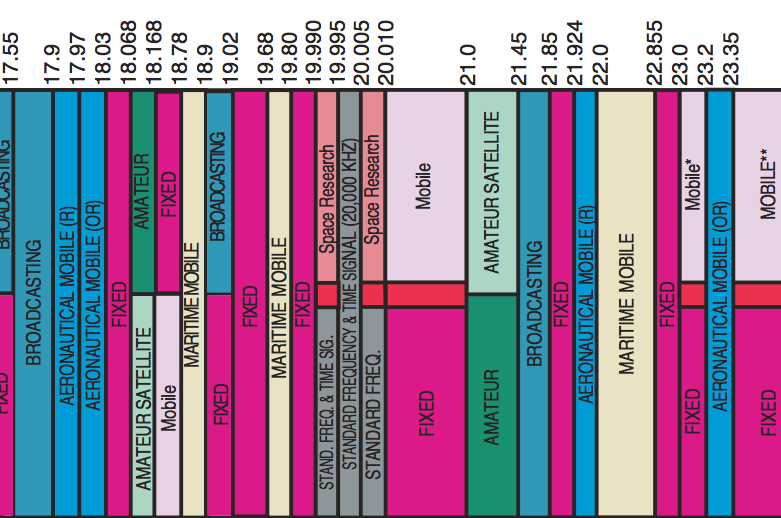

Sun Location
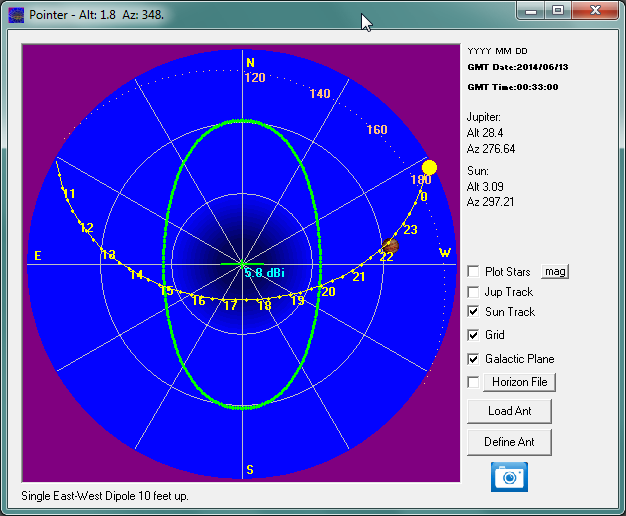
The Sun was only 3.09 degrees above the horizon when the solar radio emission occurred.
Tektronix MDO4104-6 Spectrum Analyzer Settings
- Spectrum analyzer is the bottom window
- 17.5 MHz start frequency
- 20.75 MHz center frequency
- 24.0 MHz stop frequency
- 6.5 MHz frequency span
- 6.5 MHz capture bandwidth
- 1 kHz resolution bandwidth
- 650 kHz per horizontal division
- 5 dBm per vertical division
- Spectrogram (waterfall) is the top window
- Spectrogram bottom is the current spectrum trace shown at the bottom of the display.
- Spectrogram top is the oldest spectrum, approximately 1 minute and 45 seconds after the current spectrum trace at the bottom.
- 328 spectrums in the spectrogram.
- 0.32 seconds per spectrum update rate.
- 3.12 spectrums per second update rate.
- Date and time in lower right corner is in UT.
- Python 2.7.6 script taking screen captures every 12 seconds
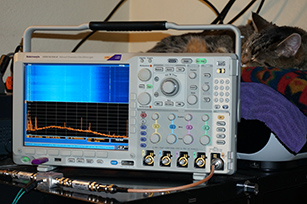
|
|
Spectrum Analyzer Equipment

SDR-IQ Receiver Video
RFSpace
SDR-IQ Receiver
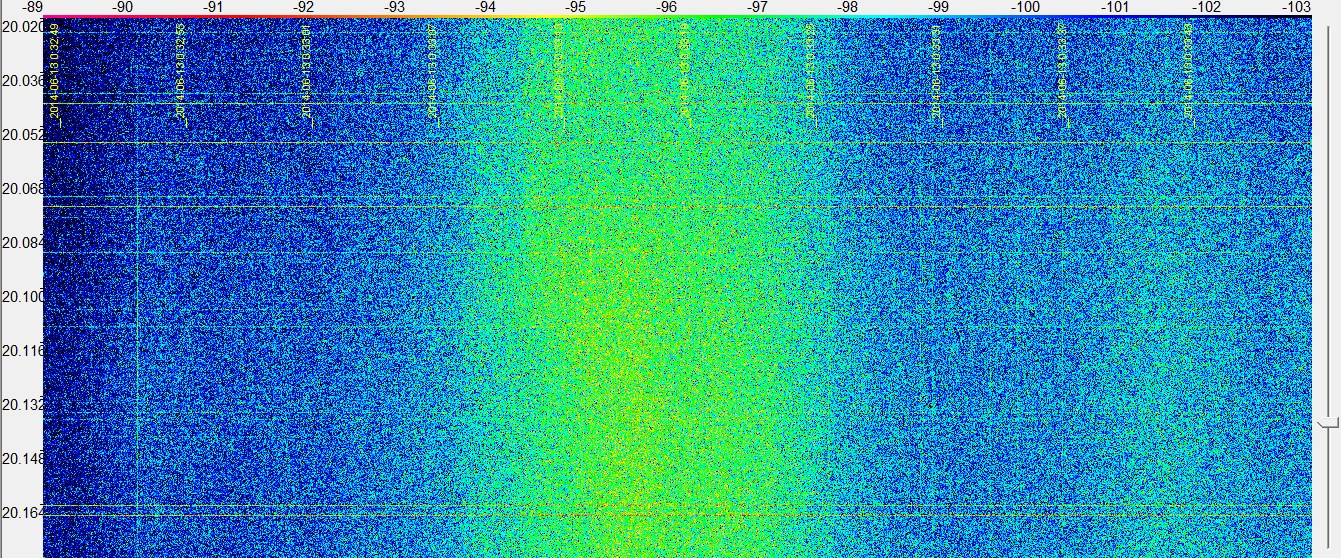

RTL-SDR Receiver Video
RTL-SDR Receiver
- Below is SDR# spectrum analyzer display showing the Sun radio emissions from approximately 26.240 MHz to 28.680 MHz.
- The Sun radio emission is the yellow-red noise in the spectrogram window.
- Spectrogram top is the current spectrum trace shown in the top window.
- Spectrogram bottom is the oldest spectrum, approximately 16 seconds after the current spectrum trace at the top.
- 3 to 4 seconds between spectrogram vertical time stamps
- The signals on the left side are the
Citizens band radio (CB radio) (26.965 MHz to 27.405 MHz).
- The signals on the right are the
10 meter
(28.0 MHz to 29.7 MHz) amateur radio band.
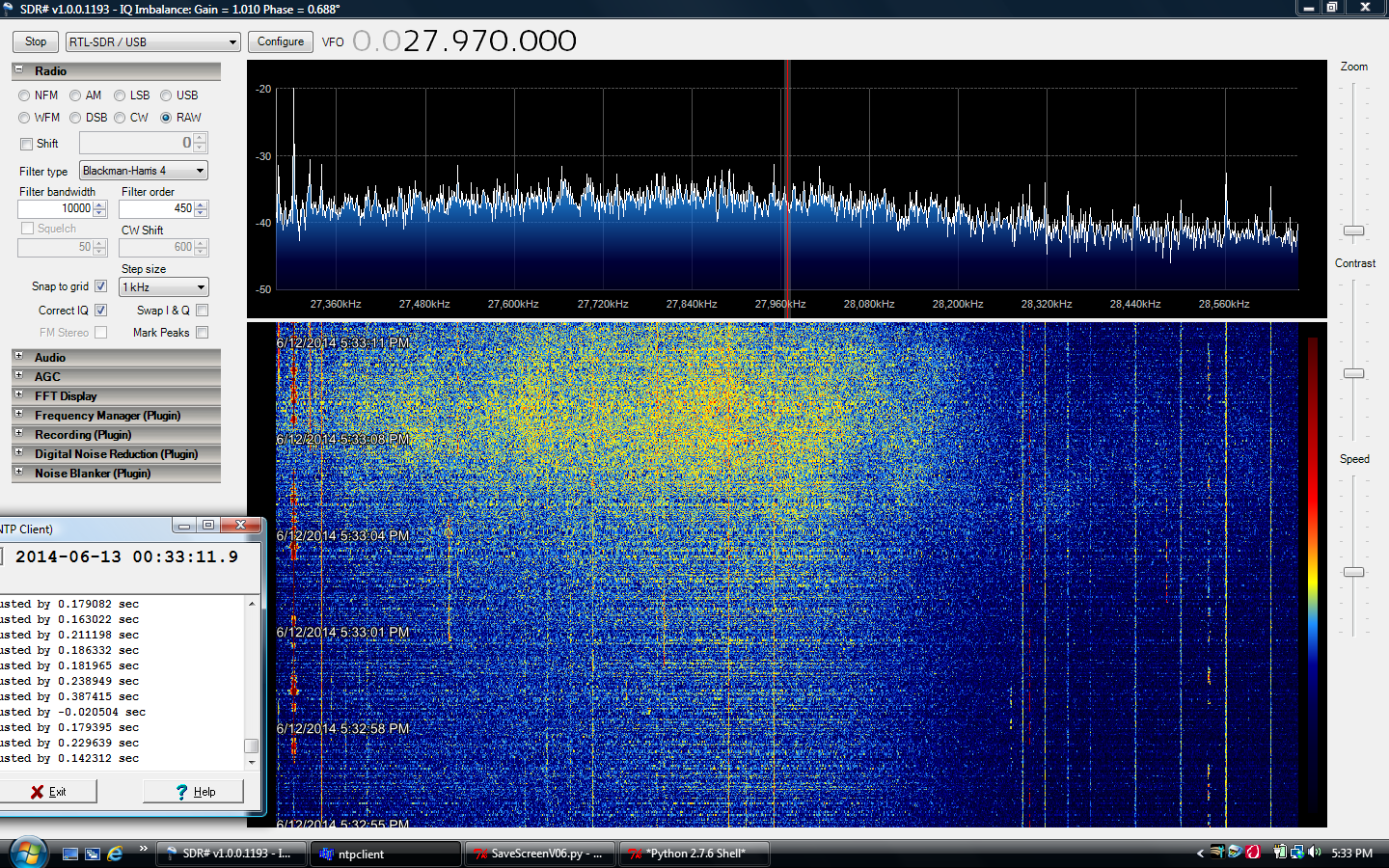
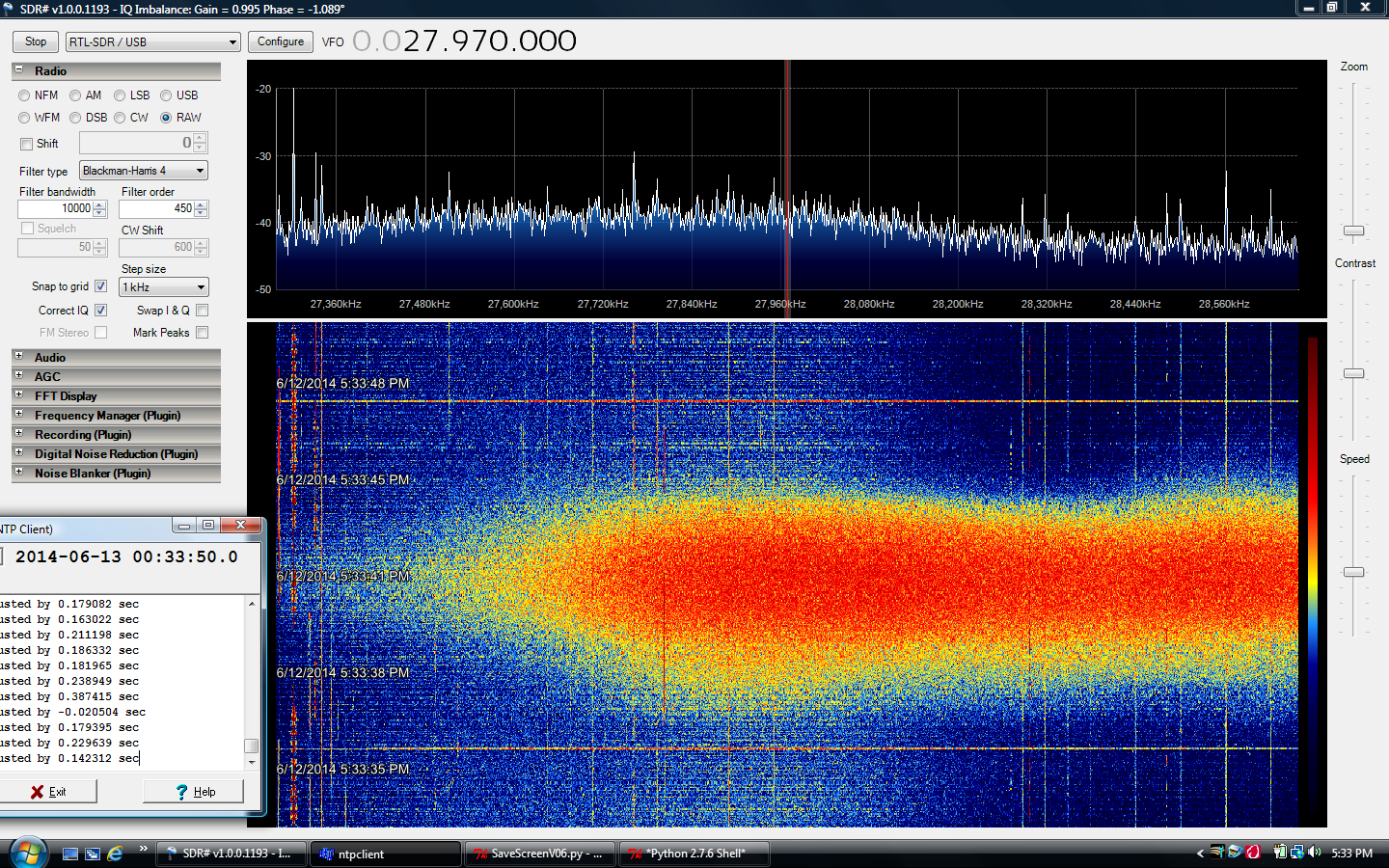

United States Frequency Allocations
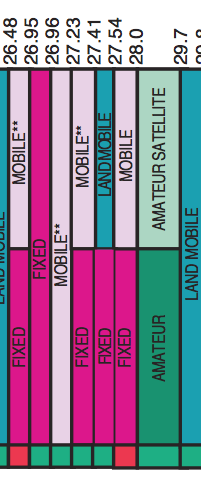
The Radio Spectrum, October 2003
U.S. DEPARTMENT OF COMMERCE
National Telecommunications and Information Administration

|
|
Hardware Equipment
- Radio: NooElec NESDR Mini SDR & DVB-T USB Stick (R820T) based on the Realtek RTL2832U and the Raphael Micro R820T
- A preselector is used to remove the strong stations from overloading the SDR.
- Antenna: Scanner Ant-Base 30-1300 Mhz by Antennacraft, includes 50 feet of RG-6
- Laptop: HP G70 NOtebook PC, Pentium Dual Core CPU, T4200 @ 2.00 GHz, 3 GB RAM, 32-bit
- Data logging to Toshiba 2TB USB hard drive

Software

Observing Information
- OBS-Time: June 13, 2014, 0033 UT
- OBS-Location: Camas, WA USA, 16.6 miles East-North-East from the center of Portland, OR, USA

Radio JOVE Data Archive Calendar

Verifying Solar Burst
NOAA/ National Weather Service
National Centers for Environmental Prediction
Space Weather Prediction Center
Solar Event Reports (Edited Events)
gt:Product: 20140613events.txt
:Created: 2014 Jun 14 1802 UT
:Date: 2014 06 13
# Prepared by the U.S. Dept. of Commerce, NOAA, Space Weather Prediction Center
# Please send comments and suggestions to SWPC.Webmaster@noaa.gov
#
# Missing data: ////
# Updated every 30 minutes.
# Edited Events for 2014 Jun 13
#
#Event Begin Max End Obs Q Type Loc/Frq Particulars Reg#
#-------------------------------------------------------------------------------
3640 + 0029 0033 0044 LEA 3 FLA S22E63 SF DSD 2092
3660 0030 0034 0041 G15 5 XRA 1-8A C8.5 3.8E-03 2087
3660 + 0031 0034 0056 LEA 3 FLA S19E45 1F ERU 2087
3660 0032 //// 0034 LEA C RSP 025-180 V/2 2087
3660 + 0033 //// 0034 CUL C RSP 018-200 III/3 2087
Obs - The reporting observatory.
CUL - Culgoora, Australia
HOL - Holloman AFB, NM, USA LEA - Learmonth, Australia
PAL - Palahua, HI, USA RAM - Ramey AFB, PR, USA
SAG - Sagamore Hill, MA, USA SVI - San Vito, Italy
Q - Quality
For radio bursts at fixed and sweep frequencies, and for storms, this
shows the quality of the data
C = Corrected report
G = Good
U = Uncertain
For optical flares, this shows the quality of observing conditions,
from 1 to 5, where: 1 = very poor and 5 = excellent
X-ray events and SXI flare have a quality of 5 (meaning excellent).
Type - Type of report, see http://www.swpc.noaa.gov/info/glossary.html
BSL = Bright surge on the limb
DSF = Filament disappearance
EPL = Eruptive prominence on the limb
FIL = Filament
FLA = Optical flare observed in H-alpha
FOR = Forbush decrease (cosmic ray decrease))
GLE = Ground-level event (cosmic ray increase)
LPS = Loop prominence system
PCA = Polar cap absorption
RBR = Fixed-frequency radio burst
RNS = Radio Noise Storm
RSP = Sweep-frequency radio burst
SPY = Spray
XFL = SXI X-ray flare from GOES Solar X-ray Imager (SXI)
XRA = X-ray event from SWPC's Primary or Secondary GOES spacecraft
RSP:
Type/Intensity
Type II: Slow drift burst
Type III: Fast drift burst
Type IV: Broadband smooth continuum burst
Type V: Brief continuum burst, generally associated with Type III bursts
Type VI: Series of Type III bursts over a period of 10 minutes or more,
with no period longer than 30 minutes without activity
Type VII: Series of Type III and Type V bursts over a period of 10 minutes
or more, with no period longer than 30 minutes without activity
Type CTM: Broadband, long-lived, dekametric continuum
Intensity is a relative scale 1=Minor, 2=Significant, 3=Major
|

NASA STEREO / WAVES
NASA WIND-WAVES: The Radio and Plasma Wave Investigation on the WIND Spacecraft
NASA STEREO (Solar TErrestrial RElations Observatory)
NASA STEREO / WAVES data
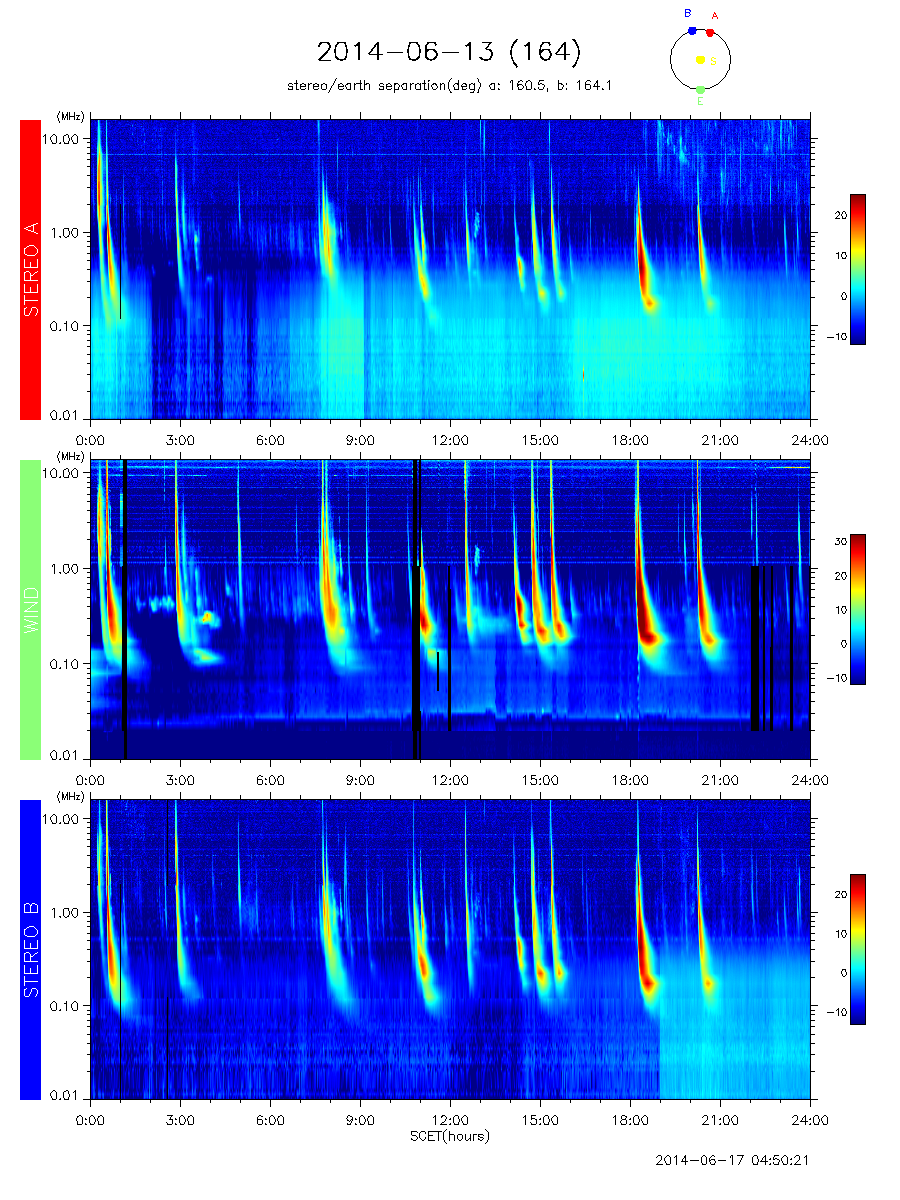


|
![]()
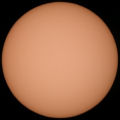
![]()








